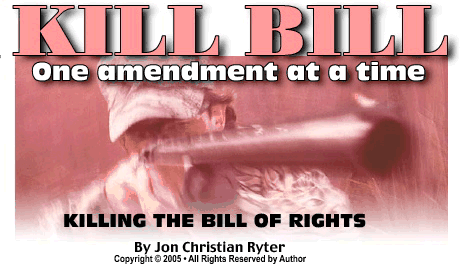
News
Behind the Headlines
Two-Cents Worth
Video of the Week
News Blurbs
Articles
Testimony
Bible Questions
Internet Articles (2015)
Internet Articles (2014)
Internet
Articles (2013)
Internet Articles (2012)
Internet Articles (2011)
Internet Articles (2010)
Internet Articles
(2009)
Internet Articles (2008)
Internet Articles (2007)
Internet Articles (2006)
Internet Articles (2005)
Internet Articles (2004)
Internet Articles (2003)
Internet Articles (2002)
Internet Articles (2001)

 he
American people have been led to believe that the USA Patriot
Act, which was speedily enacted on October 26, 2001, originated
in the passion of President George W. Bush's words in early
October when he stood on a soapbox of hot ashes at the site of
the smoldering ruins of the World Trade Center and demanded that
Congress move swiftly to create the legislation needed to protect
the American people from terrorists. Within
three weeks of his impassioned speech, the USA Patriot Act—that
was theoretically crafted by equally patriotic Senators and Congressmen—was
being debated in both Houses of Congress.
he
American people have been led to believe that the USA Patriot
Act, which was speedily enacted on October 26, 2001, originated
in the passion of President George W. Bush's words in early
October when he stood on a soapbox of hot ashes at the site of
the smoldering ruins of the World Trade Center and demanded that
Congress move swiftly to create the legislation needed to protect
the American people from terrorists. Within
three weeks of his impassioned speech, the USA Patriot Act—that
was theoretically crafted by equally patriotic Senators and Congressmen—was
being debated in both Houses of Congress. 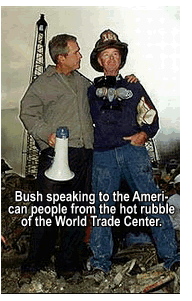 Within
days it was enacted and signed into law by the President of the
United States with much patriotic fanfare. It was a law, the President
said, that was good for America. Only, why was a law that was
good for the American people so secretive that, according to Congressman
Ron Paul [R-TX], no member of Congress was allowed to read
it before they voted on it?
Within
days it was enacted and signed into law by the President of the
United States with much patriotic fanfare. It was a law, the President
said, that was good for America. Only, why was a law that was
good for the American people so secretive that, according to Congressman
Ron Paul [R-TX], no member of Congress was allowed to read
it before they voted on it?
The Bush Administration utilized the same tactics Franklin D. Roosevelt used on March 9, 1933 when Congress enacted the Emergency Banking Relief Act after a combined total of 40 minutes of debate from both sides—most of which time was spent arguing that Congress had never seen the bill, had never read the bill—or, for that matter, even knew of its existence before they were asked by the House and Senate leadership to enact it. Not even the members of the House and Senate Banking Committees knew of the bill existence.
In less than twelve
hours Congress enacted the Emergency Banking Relief Act of
1933 and saw it signed into law—completely oblivious
that within it was a revision of the Trading With the Enemy
Act of 1917 that would change, for all time, the relationship
between the people and the government. With a stroke of the pen,
Roosevelt reclassified the American citizen as an enemy
of its own government. (r).jpg) Before
midnight on March 9, 1933, FDR signed Public Law 1
and an adversarial "relationship" between citizen and government
was created that still exists today.
Before
midnight on March 9, 1933, FDR signed Public Law 1
and an adversarial "relationship" between citizen and government
was created that still exists today.
Also buried in that legislation was a clause that allowed the Roosevelt Administration to steal from the American people all of the gold they legally possessed in the form of gold coins or gold certificates that were redeemable in gold. When the Congress met at noon that day, the American people were the wealthiest in the world. By midnight, they were permanently stripped of that wealth. Taken from the people, almost at the point of a gun, was their gold—specie—that was pocketed by the greedy bankers and merchant princes. Replacing it in the most diabolical scheme ever invented by man, were IOUs affirming that the government owed them that amount of money redeemable in more worthless scrip IOUs that were called Federal Reserve Notes and disguised to look like real money.
On Jan. 4, 1934 Congress passed the Gold Reserve Act of 1934. Roosevelt immediately devalued the dollar. What was worth 100 cents on Jan. 3 was worth 41 cents on Jan. 4. With that stroke of the pen, Roosevelt stole 59% of the buying power of the American workers that had elected him a year earlier on the promise that he would restore the wealth of America—giving a whole new meaning to the phrase the pen is mightier than the sword. Not even a bandit with a gun could have stolen as much wealth from the American people as Roosevelt did that day.
Failing to learn from history 82 years later, Congress regularly enacts laws written by special interest groups that fill the campaign coffers of Congressmen and Senators who then "sponsor" the legislation as their own. Summaries—talking points for the media—(crib notes, if you will) of the enrolled bills are given to Congressmen and Senators whose votes are usually committed to the legislation before the crib notes ever end up in the hands of the Congressman's legislative director. In other words, Congress has been voting blindfolded backroom deals since 1933. When people comment that "justice is blind," you have no idea just how much truth is in their words.
The legislation that became the USA Patriot Act of 2001 was actually pretty much same bill as the 1995 version of HR 666 and S.735—with word and phrase changes to update the language. But the same unconstitutional abrogation of the Bill of Rights found in HR 666 was present in the Patriot Act, too.
 The
Comprehensive Anti-Terrorist Act of 1995 that came on the
heels of the Oklahoma City tragedy when domestic terrorist Timothy
McVeigh and an al Qaeda operative believed to be Hussain
al-Hussaini blew up the Alfred P. Murrah Federal Building
on April 19, 1995.
The
Comprehensive Anti-Terrorist Act of 1995 that came on the
heels of the Oklahoma City tragedy when domestic terrorist Timothy
McVeigh and an al Qaeda operative believed to be Hussain
al-Hussaini blew up the Alfred P. Murrah Federal Building
on April 19, 1995.
Before most Americans even knew there was an anti-terrorist bill speeding through Congress, it had already been passed by the Senate on a 91 to 8 vote. As HR 666 was being quietly debated in the House Judiciary Committee details of its Bill of Rights abrogations were leaked to the media by Congressmen on both sides of the aisle.
The original Clinton version of the Comprehensive Anti-Terrorist Act of 1995 would have legislatively—albeit unconstitutionally—abolished the Bill of Rights. Had HR 666 been enacted, it would have taken a giant bite out of liberty. Today the globalists are counting on eliminating the sunset clause in Patriot I and enacting Patriot II to accomplish what they failed to achieve in 1995. If that happens, you will have no more rights than the average Muslim insurgent being held for up to two and a half years with no charges filed against them—and no right to see an attorney.
Under HR 666, the 1st Amendment would have been completely eviscerated. Americans would have lost the right to worship God in the manner of their choosing; freedom of speech and, under unspecified "national security" circumstances, freedom of the press would have vanished as well. The right to petition the government for redress of issues would likewise have no longer existed—even though the government has technically not allowed private citizens to address grievances to the federal government since 1798 when John Adams' Federalist Congress enacted The Sedition Act of 1798. The Sedition Act made it a crime to speak out against any elected official in the federal government.
Even after ten colonial citizens had their property seized and received 2 year prison sentences for criticizing John Adams, the Supreme Court—which should have ruled that the Sedition Act was unconstitutional—did nothing. (Actually, that's not really true since those imprisoned for making seditious statements against Adams were actually tried for their "crime" by the high court.)
Because the Supreme Court would not invalidate the Sedition Act, the States took it upon themselves to do so by enacting the Kentucky and Virginia Resolves. In the Resolves, the States reiterated that they had the right under the 10th Amendment to nullify any law enacted by the federal government which the States believed was contrary to the Constitution.
The people of the United States showed their contempt for the Federalist Party by denying John Adams re-election. The media of the day called the Election of 1800 the Revolution of 1800. European-style rule by the aristocracy was greatly diminished by the Sedition Act of 1798. The Federalist Party itself also died, and was officially buried in 1828. No Federalist candidates were elected for any office higher than Congressman after 1804.
The aristocracy, however, continued to rule America—but they were forced to govern through a power-sharing Republic. With few exceptions—Andrew Jackson being the first—the American aristocracy (descendants of the lords and dukes who, themselves, were kin to the crown heads of Europe) have occupied the White House for 227 years.
Under HR 666,
the 2nd Amendment would have been legislatively abolished. Private
citizens would no longer be allowed to possess firearms of any
type.Congress knew it lacked
the authority to eradicate constitutional rights with the stroke
of a pen. 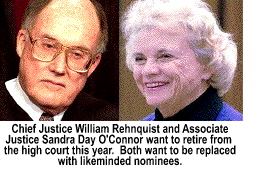 However,
the legislators also knew from experience that if they got such
a law on the books, liberal judges in the lower federal courts
would uphold the law, and the Supreme Court—with just one
more liberal justice to replace either Chief Justice William
Rehnquist or Sandra Day O'Connor—will seal the
fate of the 2nd Amendment for all time. Once the 2nd Amendment
topples, the balance of the Bill of Rights will collapse like
a house of cards, and the unrestricted liberty of the American
people will be replaced with the limited rights found in
the UN Declaration on Human Rights. The Anti-Terrorist
Act of 1995 would have also wiped out the 3rd Amendment and
Posse Comitatus by allowing the government to use military
troops as police officers.
However,
the legislators also knew from experience that if they got such
a law on the books, liberal judges in the lower federal courts
would uphold the law, and the Supreme Court—with just one
more liberal justice to replace either Chief Justice William
Rehnquist or Sandra Day O'Connor—will seal the
fate of the 2nd Amendment for all time. Once the 2nd Amendment
topples, the balance of the Bill of Rights will collapse like
a house of cards, and the unrestricted liberty of the American
people will be replaced with the limited rights found in
the UN Declaration on Human Rights. The Anti-Terrorist
Act of 1995 would have also wiped out the 3rd Amendment and
Posse Comitatus by allowing the government to use military
troops as police officers.
HR 666 would have also eliminated the 4th Amendment's protection from unreasonable searches and seizure, and it would have repealed habeas corpus. The right to due process, and the right not to incriminate oneself under the 5th Amendment would have been erased under HR 666.
Anyone accused of a crime under the new legislation could have been held indefinitely without being charged, and that person's assets would be subject to immediate seizure. As such, the accused would no longer possess the ability to hire adequate counsel since he would no longer have the financial resources to do so. And even if he won in court, his assets would never be returned without launching a successful lawsuit against the government to have them—or their value—returned. And, of course, with no assets to use in his own defense, no lawyer would take his case. On top of that, since suing for return of seized assets is a civil rather than criminal matter, that person would not be eligible for a public defender. The government has mastered the art of stifling legal protest.
Finally, HR 666 would have also abolished the 10th Amendment and the States would forever lose the right to nullify federal laws that violated the Constitution. The federal government would have total dictatorial power over every aspect of life in the United States.
It's important to remember that in 1995 the proposed anti-terrorist legislation was not aimed at foreign terrorists. Few Americans at that time had ever heard the words "Taliban" or "al Qaeda"—or Osama bin Laden. The Comprehensive Anti-Terrorist Act of 1995 was primarily designed to target domestic terrorists—American citizens.
Had the abrogations of liberty contained in HR 666 not caused a public outcry, the Bill of Rights would have been legislatively abolished a decade ago. Would the US Supreme Court have stepped in and ruled the Comprehensive Anti-Terrorist Act of 1995 unconstitutional had it gotten through Congress in its original form? What do you think? We currently have the USA Patriot Act, which violates the Bill of Rights. It's the same high court. Same justices. Have they ruled the Patriot Act unconstitutional?
The utopians at the gates of liberty are still nibbling away at the Bill of Rights, and even though civil libertarians are screaming about the intrusions of our rights under the USA Patriot Act, the federal courts—in particular the US Supreme Court—which should have declared the Patriot Act unconstitutional, have been surprisingly mute.
Since September 11, 2001 the United States courts have turned a blind eye on the Bill of Rights, accepting from George W. Bush the trite Rooseveltian excuse that the current national emergency trumps civil liberty.
Our government has resorted to legalizing the same types of practices that despotic rulers and totalitarian regimes use to control their societies. And despite the obligation government has to protect its citizens, the laws enacted by the United States over the past three decades have made it virtually impossible for the people to defend themselves against intruders, rapists and murderers. Most of those types of laws—particularly those which restrict the 2nd Amendment—were not enacted to catch criminals; they were enacted to make it more difficult, if not actually prevent, law-abiding citizens from purchasing weapons that constitutionally should be available to them.
The Comprehensive Anti-Terrorist Act of 1995 and the USA Patriot Act of 2001 both reflect the growing fear the American government has of its people for two reasons. First, the American people live in the last nation in the world where all of the people—as a free society—have an unrestricted legal right to purchase and possess firearms that the government cannot deny. Second, the American people are the only people in the world who were able, using their limited "civilian" firepower, to overthrow a tyrannical ruler, break the shackles of economic and political bondage, and form a free society in which the right to own firearms remained sacrosanct.
We are free today not because of the 1st Amendment guaranteed us a free press, or because the 4th Amendment kept us free from unreasonable searches or the seizure of our property by the government without due process (which, of course is not true today since the government regularly seizes our property without ever charging us with a crime); or because the 5th Amendment prevents the government from holding us without charges; or because the 6th Amendment demands that we be given a speedy, public trial if we are charged with a crime.
We are free today because the 2nd Amendment does today what it did in 1775—it guarantees that the American people have the means to take their nation back if the government ever attempts to subjugate the people.
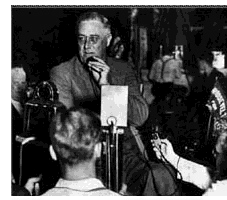 In
fact, the third and last time that the US Supreme Court heard
a 2nd Amendment case, the justices—who in 1939 understood
why the 2nd Amendment existed—arrived at the same conclusion
as the US District Court for the Western District of Arkansas,
which declared FDR's National Firearms Act of 1934
unconstitutional. The US Supreme Court decided in United States
v Miller 307 US 174 [1939] that the purpose of the 2nd Amendment
was not to restrict the rights of the people to own firearms,
but to protect the people from their government.
In
fact, the third and last time that the US Supreme Court heard
a 2nd Amendment case, the justices—who in 1939 understood
why the 2nd Amendment existed—arrived at the same conclusion
as the US District Court for the Western District of Arkansas,
which declared FDR's National Firearms Act of 1934
unconstitutional. The US Supreme Court decided in United States
v Miller 307 US 174 [1939] that the purpose of the 2nd Amendment
was not to restrict the rights of the people to own firearms,
but to protect the people from their government.
Further, the Supreme Court ruled on May 19, 1939 that it was the inherent belief of the Founding Fathers that the people might someday have to fight an oppressive government, and therefore, it was in the best interests of the nation that the people be as well-armed as its government. The court further held that the National Firearms Act was an attempt by Congress to usurp the powers reserved for the States (i.e., gun control).
The US Supreme Court—which had just survived FDR's court-stacking scheme to control of the decisions coming from the high court—realized that Franklin Delano Roosevelt intended to consolidate political power in the United States under the Executive Branch with himself as the lifetime head of a democratic dictatorship. For a very brief moment, the justices of the Supreme Court saw, first hand, what the Founding Fathers feared—an overreaching Executive with the power to entice the legislative and judicial branches to join the executive branch to subvert the nation.
The Ageless Agenda
The
federal government's war on the 2nd Amendment, blamed on Bill
Clinton by most diehard right-of-center conservatives, actually
began during the presidency of John F. Kennedy, shortly
after the abortive Bay of Pigs fiasco. The game plan, known as
State Department Publication 7277, was entitled Freedom
from War: 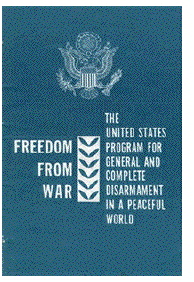 The
United States Program for General and Complete Disarmament in
a Peaceful World.
The
United States Program for General and Complete Disarmament in
a Peaceful World.
While most Americans today are aware of the fact that Publication 7277 called for the gradual transfer of all American military assets—men and machines—to the United Nations (which is forbidden by its charter from fielding an army), most people don't know that 7277 also detailed plans for the global disarming of private citizens as well. It would not bode well for the utopians to disarm the governments of the world and leave their people armed to the teeth.
The
authors of the Kennedy plan—or rather, the Council
on Foreign Relations plan since that is where the disarmament
agenda was born—were CFR members Dean Rusk,
Kennedy's Secretary of State, Secretary of Defense Robert
McNamara and presidential advisors John McCloy and
Robert Lovett. McCloy would be appointed to head
the newly created US Arms Control and Disarmament Agency
the following year. Lovett was offered his choice of cabinet
positions in the Kennedy Administration and reportedly
turned all of them down. He preferred the role of invisible advisor.
In that capacity, Lovett handpicked most of those who became
the inner circle of both the Kennedy and Johnson Administrations.
.jpg) Banning
the private ownership of guns in America became the unspoken agenda
of Congress even though since 1968 legislators on both sides of
the aisle insisted that their intent was never to ban the private
ownership of guns but simply to regulate them to make sure that
guns didn't get in the hands of criminals.
Banning
the private ownership of guns in America became the unspoken agenda
of Congress even though since 1968 legislators on both sides of
the aisle insisted that their intent was never to ban the private
ownership of guns but simply to regulate them to make sure that
guns didn't get in the hands of criminals.
In point of fact, criminals don't go to the neighborhood gun store to purchase firearms. They buy guns on the black market from "dealers" who usually have criminal records themselves—and who sell their inventories of guns from the back trunks of their cars. More often than not, the guns the blackmarket dealers sell are not American-made firearms. They are guns manufactured in, and smuggled from, Central and South America, China and the Mideast. A small amount of the guns used in crimes in the United States are weapons that were stolen from American citizens who purchased and owned them legally. Acting as though the majority of the guns used in crimes were stolen from careless gun owners, Congress attempted to enact legislation that would have made legal gun owners whose weapons were stolen—and the gun dealers from whom they were legally purchased—financially responsible for any crimes committed with those weapons.
Four
years after the enactment of the National Firearms Act, Roosevelt
tried a second time to outlaw the private ownership of guns. This
time, the legislation was called the Federal Firearms Act of
1938. 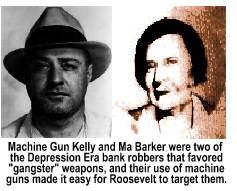 The
new law banned "gangster weapons" (tommy guns made popular
not only by the Chicago bootleg gangs during Prohibition but gangsters
like Machine Gun Kelly and Ma Barker). The law also
banned "silencers" and all gadget-type guns such as
"gentlemen" guns (those unobtrusively hidden in fancy
canes) or those having the appearance of being cosmetic jewelry.
The law expanded on the National Firearms Act by banning
all short-barreled rifles and shotguns. What Roosevelt
especially wanted banned were revolvers and pistols since Guiseppe
Zangara used a .38 revolver when he attempted to assassinate
FDR
The
new law banned "gangster weapons" (tommy guns made popular
not only by the Chicago bootleg gangs during Prohibition but gangsters
like Machine Gun Kelly and Ma Barker). The law also
banned "silencers" and all gadget-type guns such as
"gentlemen" guns (those unobtrusively hidden in fancy
canes) or those having the appearance of being cosmetic jewelry.
The law expanded on the National Firearms Act by banning
all short-barreled rifles and shotguns. What Roosevelt
especially wanted banned were revolvers and pistols since Guiseppe
Zangara used a .38 revolver when he attempted to assassinate
FDR  on
Feb. 15, 1933—nineteen days before FDR was to assume
office as the 32nd President of the United States. Zangara
fired five times at Roosevelt but succeeded only in killing
Chicago mayor Anton Cermack. Zangara was tried for
the murder Cermack and the attempted murder of the president-elect.
He was found guilty and sentenced to death. The sentence was quickly
carried out in Florida's electric chair.
on
Feb. 15, 1933—nineteen days before FDR was to assume
office as the 32nd President of the United States. Zangara
fired five times at Roosevelt but succeeded only in killing
Chicago mayor Anton Cermack. Zangara was tried for
the murder Cermack and the attempted murder of the president-elect.
He was found guilty and sentenced to death. The sentence was quickly
carried out in Florida's electric chair.
It is
important to note that in 1928 the freely-elected conservative
Reichstag in Germany attempted to curtail the right of
its citizens to own handguns not only out of fear of both the
Nazis and the Communist—or because of the dramatic increase
in political assassinations throughout Europe—but to show
good faith to the League of Nations scheme to end war by
gradually eliminating the weapons used to fight them. 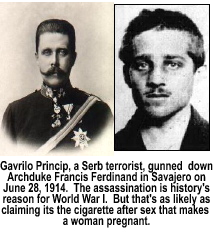 The
global effort to ban guns began with a rash of political assassinations
in Europe during the American Civil War, culminating with the
assassination of Austrian Archduke Francis Ferdinand and
his commoner wife were gunned down in Sarajevo by anarchist Gavrilo
Princip on June 28, 1914. When the first World War ended,
the utopians—who still insisted that the assassination of
the Archduke started the global war—were more determined
than ever to disarm the people as the League of Nations
disarmed their governments since it was armed anarchists and patriots
who overthrew the Old World Order of Europe, creating parliamentary
democracies out of Europe's monarchies. By the mid-1920's, as
the League of Nations developed its plan to erase all national
borders and create a single global nation, a wave of European
national laws were being enacted to deprive European citizens
of the right to own firearms. The disarmament laws made sense
since, clearly, the people of all the nation-states would attempt
a coup if their government capitulated to the bankers and industrialists
and surrendered their nation's sovereignty without firing a shot.
The
global effort to ban guns began with a rash of political assassinations
in Europe during the American Civil War, culminating with the
assassination of Austrian Archduke Francis Ferdinand and
his commoner wife were gunned down in Sarajevo by anarchist Gavrilo
Princip on June 28, 1914. When the first World War ended,
the utopians—who still insisted that the assassination of
the Archduke started the global war—were more determined
than ever to disarm the people as the League of Nations
disarmed their governments since it was armed anarchists and patriots
who overthrew the Old World Order of Europe, creating parliamentary
democracies out of Europe's monarchies. By the mid-1920's, as
the League of Nations developed its plan to erase all national
borders and create a single global nation, a wave of European
national laws were being enacted to deprive European citizens
of the right to own firearms. The disarmament laws made sense
since, clearly, the people of all the nation-states would attempt
a coup if their government capitulated to the bankers and industrialists
and surrendered their nation's sovereignty without firing a shot.
England was first, enacting the Firearms Act of 1920. The Firearms Act of 1920 gave the British Home Office sole authority to issue licenses for firearms. For that reason, very few licenses were issued. Only the titled or the wealthy, or those employed by the titled or wealthy were able to obtain them. Owning an unlicensed firearm carried a stiff penalty. A gun roundup began even though the English Bill of Rights (1689) ostensibly granted its citizens the right to own firearms. "The [English] subjects which are Protestants, may have arms for their defense suitable to their conditions, as allowed by law." "As allowed by law" is the catch-phrase that permeates the UN Declaration on Human Rights. It's the waiver that allows government to retract any right on whim, and exclude anyone it wishes from the liberties granted by that right.
The Law on Firearms and Ammunition of 1928 was the first attempt by Germany to register firearms and regulate who could legally possess them. This was done, in part, to persuade their former enemies of their willingness to live in a war-free world. But, the government also feared the increasing number of anarchist socialists and fascists who were causing civil unrest from Bavaria to Berlin. The government feared a coup by either Bolesheviks or Nazis.
Negotiations between US Secretary of State Frank Kellogg, French Foreign Minister Aristide Briand and emissaries from England, Belgium, France, Poland, Australia, New Zealand, South Africa, Germany, the Czech Republic, Ireland, India, Japan, Italy, and the United States in 1928 created what became known as the Kellogg-Briand Pact—a universal nonaggression program for the world that was written by the fledgling Council on Foreign Relations for the fledgling League of Nations. In this accord was the spirit that would ultimately be incorporated into State Department Publication 7277—complete and total disarmament. Nations and peoples.
Interestingly, in 1938 when Hitler was already flexing his muscles in Europe, and the threat of war with Germany was looming large in the minds of most Europeans, the British Home Office pulled the plug on issuing new gun licenses to British citizens who requested permission to buy handguns or rifles to protect their homes and families in the event the nation was invaded by Germany. Not only did the Home Office decline to issue new permits, it revoked many of the licenses it previously granted. Then, in a bizarre move to most, the British government passed a comprehensive firearms statute that eliminated the right of most British citizens to be armed. To many, it seemed that the government was preparing for the English people to capitulate should the Huns invade.
The rationale for disarming people whom the British government should have been arming was due—according to a secret report that was declassified in the late 1970s—a growing fear by the British government that a communist or fascist revolution by the people of England was planned and might be staged just as the Germans invaded the island nation.
Whenever governments fear its citizens, the first thing those governments will do is disarm its citizens to protect itself from the people. A citizen militia armed with nothing more threatening than scythes, garden hoes, lawn rakes and axes does not pose much of a threat to a government armed with machine guns, tanks and guided missiles.
In Europe today, only one nation has never been invaded. Switzerland. During World War II, only one nation in Europe was allowed absolute neutrality. Switzerland. During the 20th century, the laws of only one nation in Europe mandated that every citizen must be armed. Switzerland. Today, in Europe, only the Swiss are armed to the teeth. Yet, Switzerland has the lowest crime rate of any industrialized nation in the world.
Using UN data compiled through 1996, the US Department of Justice concluded that, in England, the robbery rate was 1.4 times higher, the assault rate was 2.3 higher, and the burglary rate was 1.7 times higher than it was in the United States. Only the murder and rape rates in the United States were higher than in England. Prior to the universal adoption of the UN Global Gun Ban Treaty by the nations of Europe and the former colonies of the British Empire (which worrisomely, has never shown up at the doorstep of the US Congress) England had the most restrictive gun control laws in the world.
The UN International Study on Firearm Regulation (1994) deliberately chose to delete Switzerland from its comparative analysis because the Swiss statistics contradict the study's hypothesis that a high rate of firearm ownership corresponds with high rates of violent crime. The Swiss Federal Police reported that, in 1997, there were 87 intentional homicides and 102 attempted homicides in the entire country. Ninety-one of the 189 incidents involved firearm. With a population of seven million (which includes 1.2 million foreigners), Switzerland had a homicide rate of 1.2 per 100,000. There were 2,498 robberies (and attempted robberies), of which 546 involved firearms, giving a robbery rate of 36 per 100,000. Almost 50% of the reported crimes were committed by nonresident foreigners, which is why one hears reference in casual talk to "criminal tourists." To the gun control advocate, the statistics from Switzerland sounds made up. In 1993, not a single armed robbery was reported in Geneva . Switzerland, which is awash in guns, has substantially lower murder and robbery rates than England, where guns are banned. The honest statistics prove that guns not only don't commit crimes, a well-armed public reduces the crime rate substantially. In addition, a well-armed nation reduces the likelihood of tyrannical governments overthrowing their citizens and establishing totalitarian dictatorships.
Had Franklin D. Roosevelt succeeded in outlawing the private ownership of guns in America as Adolph Hitler did in Germany and Josef Stalin did the Soviet Union—and ultimately, what Mao Tse-tung did when he seized China in 1949—FDR would have invoked an emergency decree suspending the Constitution during the "national emergency," and would have become America's second dictator. Only, in Roosevelt's case, the power would never have been returned to the people.
The Gun Control
Act of 1968 actually began as the Gun Control Act
of 1963 shortly after the assassination of President John
F. Kennedy in Dallas, Texas. Congress'
attempt to play on the emotions of America and use the passionate
sentiments of people who were mourning the loss of a popular president
to sidestep the constitutionality issues of proposed legislation
that would have virtually outlawed the private ownership of guns.
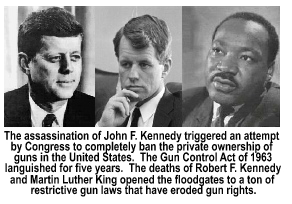 However,
most of the members of Congress knew they wouldn't get reelected
if they legislatively abolished the 2nd Amendment—or even
attempted to do so since, until 1969, virtually every high school
in the United States had a shooting club—using guns and the
ammunition supplied by the American military establishment. The
Gun Control Act of 1963 languished in Congress for
five years before the dual assassinations of Robert F. Kennedy
and Martin Luther King in 1968 brought a greatly modified
and much more moderate version of that legislation out of committee
as the Gun Control Act of 1968. Prior to 1968, all of the
federal gun laws combined contained 19,907 words. The original
National Firearms Act of 1934 contained only 3,571 words.
Gun control legislation in the State of California for the year
1997 contained 158,643 words. Today, just about any piece of gun
legislation in the federal system contains more words than Carroll
Quigley's voluminous 1,311 page utopian tome Tragedy &
Hope.
However,
most of the members of Congress knew they wouldn't get reelected
if they legislatively abolished the 2nd Amendment—or even
attempted to do so since, until 1969, virtually every high school
in the United States had a shooting club—using guns and the
ammunition supplied by the American military establishment. The
Gun Control Act of 1963 languished in Congress for
five years before the dual assassinations of Robert F. Kennedy
and Martin Luther King in 1968 brought a greatly modified
and much more moderate version of that legislation out of committee
as the Gun Control Act of 1968. Prior to 1968, all of the
federal gun laws combined contained 19,907 words. The original
National Firearms Act of 1934 contained only 3,571 words.
Gun control legislation in the State of California for the year
1997 contained 158,643 words. Today, just about any piece of gun
legislation in the federal system contains more words than Carroll
Quigley's voluminous 1,311 page utopian tome Tragedy &
Hope.
It should be clear to you by now that what appears on the surface to be nothing more than spontaneous efforts based on emotional yet rational responses to tragedies caused by senseless acts of gun violence to ban the private ownership of guns is a well orchestrated global plan to use tragedy whenever it occurs to achieve the ageless agenda of both the Old World and New World Orders—the universal and complete disarmament of both nations and peoples.

Copyright © 2009 Jon Christian Ryter.
All rights reserved.



